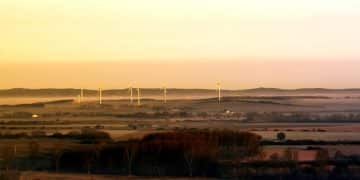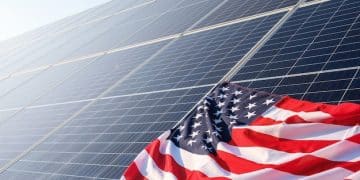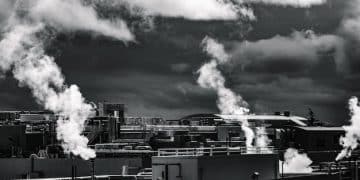Exploring the Impact: Executive Order on Climate Change & US Energy Policy
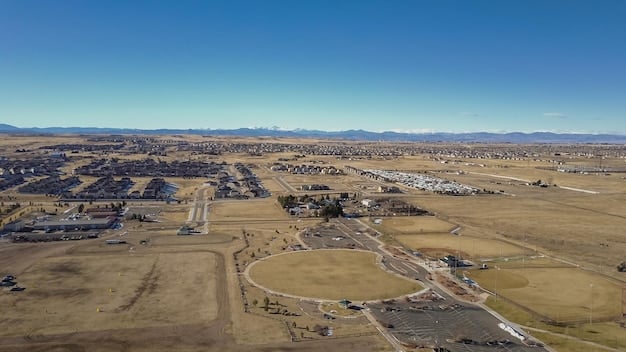
The recent executive order on climate change is poised to reshape US energy policy by accelerating the transition to renewable sources, setting stricter emission standards, and promoting sustainable practices across various sectors.
The implications of the recent executive order on climate change for US energy policy are far-reaching, potentially altering the landscape of how the nation produces, distributes, and consumes energy. This article delves into the key areas affected by the order, examining both the intended benefits and potential challenges.
Understanding the Executive Order
To fully grasp the implications of this executive order, it’s essential to understand its core tenets. The order aims to reduce greenhouse gas emissions, promote clean energy technologies, and ensure that the US achieves net-zero emissions by 2050. These goals are to be achieved through a variety of policies and initiatives.
Key Provisions of the Order
The executive order encompasses several key provisions designed to drive the transition to a cleaner energy economy. These provisions include setting ambitious targets for renewable energy production, increasing energy efficiency standards, and investing in sustainable infrastructure.
- Directing federal agencies to prioritize climate considerations in their decision-making processes.
- Halting new oil and gas leases on public lands and waters.
- Promoting the development of offshore wind energy.
- Investing in research and development of carbon capture technologies.
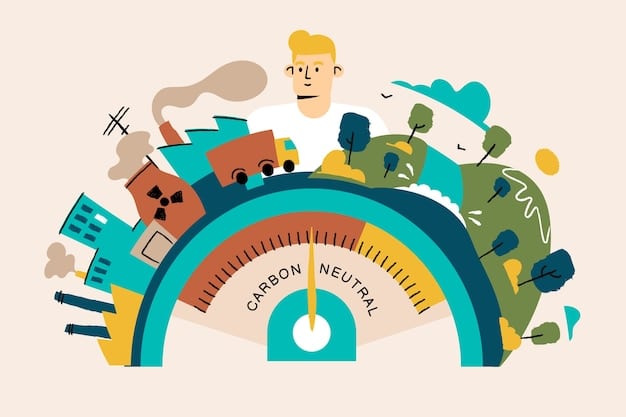
These provisions are intended to create a cohesive and comprehensive approach to addressing climate change within the energy sector. By aligning federal policies with climate goals, the executive order seeks to accelerate the adoption of sustainable energy practices across the nation.
Impact on Renewable Energy Sources
One of the most significant implications of the executive order is the boost it provides to renewable energy sources like solar, wind, and geothermal. With increased federal support and investment, these technologies are poised to play a much larger role in the US energy mix.
Solar Energy Expansion
The executive order aims to substantially increase solar energy production through tax incentives, grants, and streamlining permitting processes. This is expected to drive down the cost of solar energy and make it more accessible to consumers and businesses.
Wind Energy Development
Offshore wind energy is another area that will benefit greatly from the executive order. The order directs federal agencies to identify and lease suitable areas for offshore wind development, as well as to accelerate the permitting process for wind energy projects.
- Increased investment in wind energy infrastructure.
- Creation of new jobs in the wind energy sector.
- Reduced reliance on fossil fuels for electricity generation.
- Enhanced energy security through diversification of energy sources.
These initiatives can lead to a more diversified and sustainable energy supply, reducing reliance on fossil fuels and promoting energy independence.
The Future of Fossil Fuels
The executive order on climate change also has profound implications for the fossil fuel industry. While not an outright ban, the order signals a clear shift away from fossil fuels and towards cleaner energy alternatives. This has sparked considerable debate and concern within the industry.
Restrictions on New Leases
One of the most contentious aspects of the executive order is the halt on new oil and gas leases on public lands and waters. This decision has been met with strong opposition from the fossil fuel industry, which argues that it will lead to job losses and reduced energy production.
Transitioning Away from Coal
The executive order is expected to accelerate the decline of the coal industry as utilities increasingly turn to cheaper and cleaner energy sources. This transition will require careful planning and support for coal-dependent communities to mitigate economic hardship.
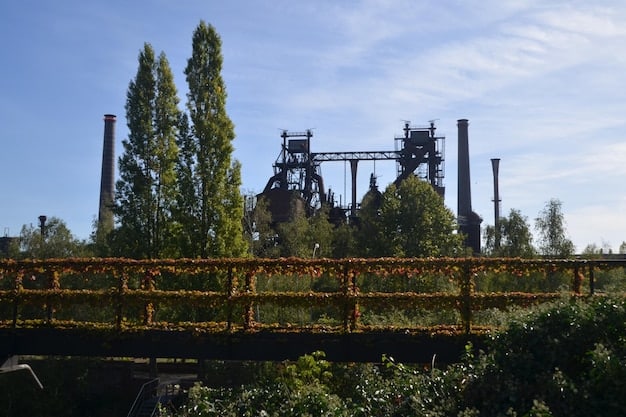
The shift away from fossil fuels also presents opportunities for innovation and growth in other sectors. Companies that invest in renewable energy technologies, energy storage solutions, and other clean energy technologies stand to benefit from the transition.
Energy Efficiency and Conservation
The executive order places a strong emphasis on energy efficiency and conservation as critical components of the climate strategy. By reducing energy consumption, the US can lower greenhouse gas emissions and reduce the need for new energy infrastructure.
Improving Building Efficiency
Retrofitting existing buildings to improve energy efficiency is another key priority. The executive order calls for incentives and programs to encourage homeowners and businesses to invest in energy-efficient upgrades, such as insulation, windows, and HVAC systems.
Transportation Sector Initiatives
The transportation sector is a major source of greenhouse gas emissions, and the executive order includes several initiatives to promote cleaner transportation options. These include investing in electric vehicle infrastructure, supporting the development of fuel-efficient vehicles, and encouraging the use of public transportation.
- Tax credits for electric vehicle purchases.
- Investments in charging infrastructure along major highways.
- Increased funding for public transportation projects.
- Stricter fuel efficiency standards for new vehicles.
Through these measures, the US hopes to accelerate the transition to a more sustainable transportation system, reducing reliance on fossil fuels and lowering emissions.
Economic and Job Impacts
The executive order on climate change is expected to have significant economic and job impacts, both positive and negative. Understanding these potential effects is crucial for developing effective policies to support workers and communities during the transition.
Job Creation in Renewable Energy
The expansion of renewable energy is expected to create a significant number of new jobs in areas such as manufacturing, construction, installation, and maintenance. These jobs will require a skilled workforce, and investments in training and education will be essential to ensure that workers have the skills they need to succeed in the clean energy economy.
Impact on Fossil Fuel Employment
The transition away from fossil fuels is likely to result in job losses in the coal, oil, and gas industries. However, these job losses can be mitigated through retraining programs, economic diversification efforts, and investments in new industries in affected communities.
The economic impacts will vary depending on the region and sector. Some areas may experience significant job growth in renewable energy, while others may face challenges related to the decline of the fossil fuel industry.
Challenges and Criticisms
Despite the potential benefits of the executive order, it also faces several challenges and criticisms. These include concerns about the economic impacts, the feasibility of achieving the ambitious emissions reduction targets, and the potential for legal challenges.
Economic Concerns
One of the main concerns is the potential economic impact of the executive order, particularly on the fossil fuel industry and related sectors. Critics argue that the restrictions on new leases and the transition away from fossil fuels will lead to job losses, reduced energy production, and higher energy prices.
Feasibility of Targets
Some experts question whether the ambitious emissions reduction targets set by the executive order are achievable, given the current state of technology and the pace of deployment of renewable energy. Achieving net-zero emissions by 2050 will require significant technological innovation, massive investments in infrastructure, and widespread adoption of sustainable practices.
Addressing these challenges and criticisms will require a collaborative effort involving government, industry, and the public.
| Key Aspect | Brief Description |
|---|---|
| ☀️ Renewable Boost | Increased support for solar, wind, and geothermal energy projects. |
| ⛽ Fossil Fuel Shift | Restrictions on new oil and gas leases on public lands. |
| ⚡ Energy Efficiency | Emphasis on reducing energy consumption. |
| 💼 Job Impacts | Potential job creation in renewable energy and shifts in fossil fuel employment. |
Frequently Asked Questions
▼
The primary goal is to reduce greenhouse gas emissions and achieve net-zero emissions by 2050, promoting a cleaner energy economy across the United States.
▼
The order will significantly boost the renewable energy sector through increased federal support, tax incentives, and streamlined permitting processes for projects like solar and wind.
▼
The order could lead to job creation in renewable energy and potential job losses in the fossil fuel industry, requiring retraining and economic diversification efforts.
▼
The order includes initiatives such as retrofitting buildings for better efficiency and promoting cleaner transportation options like electric vehicles and public transport.
▼
Conclusion
In conclusion, the recent executive order on climate change for US energy policy marks a pivotal moment in the nation’s approach to energy production and consumption. While challenges and uncertainties remain, the order sets a clear direction towards a more sustainable and climate-conscious future, with potentially transformative impacts on the economy, environment, and society.
